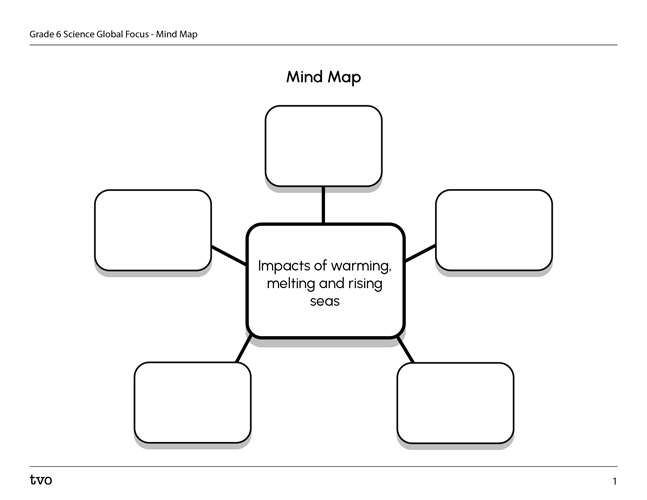Minds On
Warming, rising sea levels

It is a well-documented global fact, by scientists and Indigenous communities alike, that the polar ice caps are melting and ocean waters are warming and rising. But why is this a concern? What does this mean for local communities and for the planet on the whole?
Brainstorm
Brainstorm
Use the following mind map to brainstorm possible reasons why the melting of ice, and warming, rising seas might be problematic.
Complete the Mind Map in your notebook or using the following fillable and printable document. If you would like, you can use speech-to-text or audio recording tools to record your thoughts.
Action
Global connection
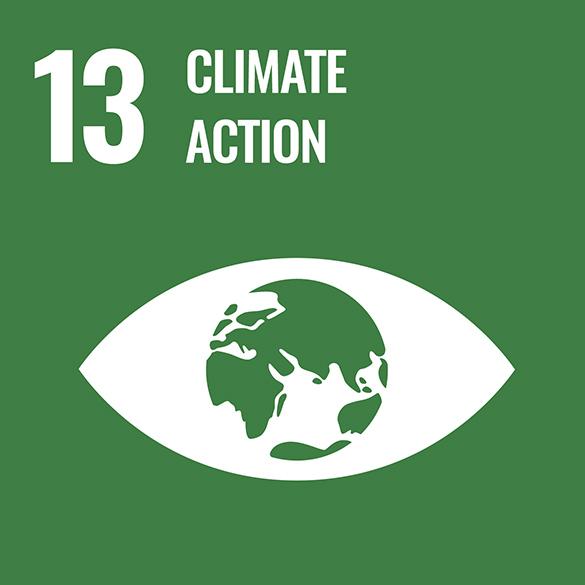
The United Nations (UN) is a group of many countries from around the world that have come together to create a better future for people and the environment. They have created 17 goals called the Sustainable Development Goals.
This learning activity is connected to Goal #13: Climate Action. This means everyone should help reduce climate change and its impact. Storms, disasters, and lack of food and water are made worse by climate change.
Climate change and rising sea levels
Rising sea levels are a concern around the world because they threaten both natural and human communities that live close to shorelines. Flooding, more severe weather, and eroding shores are just some of the major impacts of the world’s rising waters.
Communities in the Arctic are experiencing climate change at a faster rate than the rest of the world. Inuit Nunangat is the homeland of Inuit in Canada. It encompasses 51 communities in Nunavut, Inuvialuit (the Northwest Territories and the Yukon), Nunavik (Northern Quebec), and Nunatsiavut (Newfoundland and Labrador) and includes land, water, and ice, which are all considered integral parts of the Inuit culture and way of life. This means that the Inuit peoples are impacted by climate change more than any other population.
Why is this happening and how does climate change relate to rising sea levels?
Let’s first review the definition of climate change.
What is climate change?
The term climate change refers to the long-term changes to our planet’s climate conditions, such as temperatures and weather patterns. Climate change can happen as a result of natural factors or human activities. In recent times, scientists have observed more rapid-than-usual changes to our climate, which are having a negative impact to life on our planet.
The more rapid than usual warming of our planet is directly responsible for rising sea levels and it impacts it in two ways.
Press the following tabs to access information on the two main causes of our rising waters and their relation to climate change.
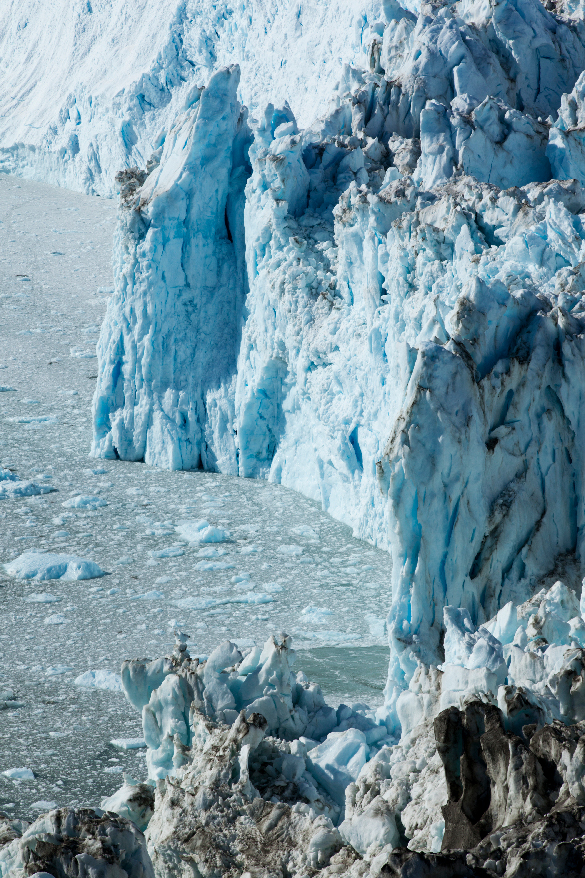
Glaciers and ice sheets are large masses of ice that rise above sea level and form part of the land. As the Earth warms, the ice from the glaciers and ice sheets melt and flow into the oceans. As this continues to happen, the levels of the water rise.

An image of Antarctica and the ice sheets and glaciers melting into the ocean. There are small chunks of snow and ice floating all around the ocean, melting into the water.
As the Earth’s temperature rises, our oceans absorb most of the heat, and as water warms, it expands meaning that it takes up more space. This results in higher water levels.
Check your understanding
Use what you have learned so far about sea levels rising to answer the following questions.
For each question, select the correct answer to complete the sentence, then press ‘Check Answer’ to see how you did.
Rising sea levels and biodiversity
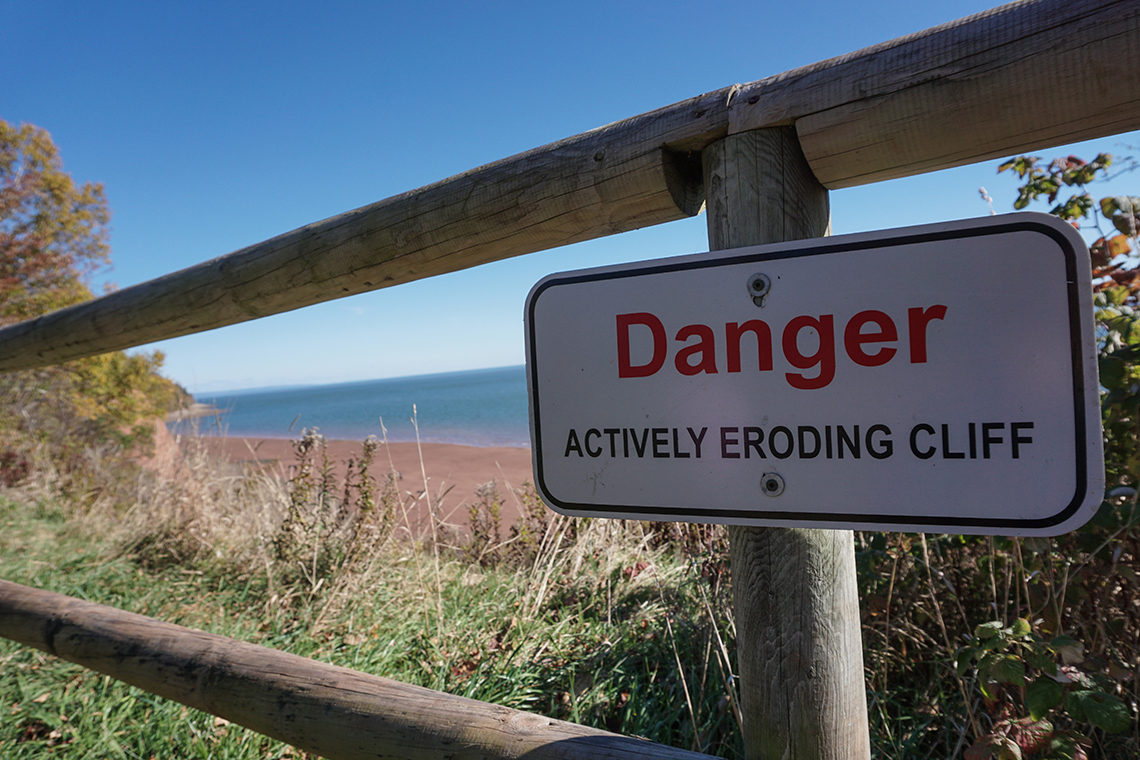
The rising water of the oceans is moving into areas that used to be land and is reducing the shorelines. This is changing the natural habitats of those areas, which threatens the survival and the biodiversity of the species in these areas.
What is biodiversity?
The term ‘bio’ refers to living things and ‘diversity’, in this instance, means variety or many differences. When we put the two terms together, biodiversity refers to the many different forms of life on our planet, the varied and unique habitats and ecosystems, and how it is all connected, either directly or indirectly.
What are the consequences of rising sea levels to biodiversity in shoreline areas?
Some of the consequences include:
- land erosion because of an increase of water means destruction of natural habitats for many species of plants, fish, birds, and other organisms
- flooding of shorelines and more severe storms because of the increase in water means significant changes to agricultural growing areas and community spaces
- eroding or reduced shorelines can also mean that some species are forced into smaller areas within their habitat which could mean less food sources and more competition for food
Some of the world’s habitats and the biodiversity in those habitats will be greatly affected by rising sea levels.
Investigate
Case study: Arctic habitats
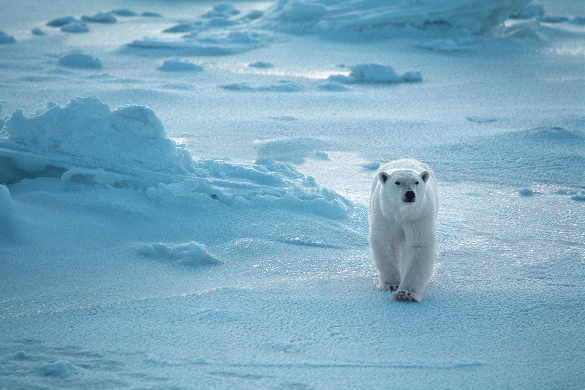
As the glaciers melt and the sea levels rise, this is limiting the hunting ground of polar bears in Arctic habitats. It also is causing a decline in the population of fish species that need cold water to survive, including trout and salmon.
The species that inhabit the arctic are used to specific, extremely cold, living conditions. A sudden change can destroy a large number of members of a specific species which puts that species at risk.
Explore this video entitled “The Big Thaw” to learn from the Water Brothers about another arctic species that is being impacted by rising sea levels as a result of climate change.
In your notebook or using a method of your choice, answer the following questions:
- Why is studying sea birds in the Arctic so important?
- What is changing about the lives of seabirds as a result of climate change?
- How does the changing lives of these birds impact global biodiversity?
Press ’Hint’ to access information presented in the video to help guide your answers.
Seabirds can give a lot of information about changing climate in the Arctic and they have a large impact on Arctic biodiversity. If the lives of the sea birds are changing because of changing temperatures, it will also show changes to the biodiversity that they share. The migration of seabirds is timed with the movement of sea ice. Because of the melting and shifting of the ice, the birds are changing their breeding schedules which also affects their migration patterns. This, in turn, greatly impacts other animals that rely on these birds as a source of food.
Pause and Reflect
Pause and reflect
Using an example of your choice, explain how different species sharing the same environment are connected to one another for survival. Why is this connection important? Explain your answer using as much detail as possible.
Record your ideas using a method of your choice such as in print, digitally or with an audio recording.
Melting ice and sea-level rise
Now that you have a greater understanding of the reasons for rising sea levels, it is time to investigate this topic further using the scientific experimentation process.
Before beginning this investigation, check out this video to learn about the steps of the Scientific Experimentation Process.
Glaciers and ice sheets rest on the land. Do you think that land ice, such as glaciers and ice sheets, contribute more to rising sea levels or the ice that is found in the sea?
Record your prediction using a method of your choice before continuing.
It’s time to experiment!
Safety
Before you explore the following experiment, let’s perform a safety check.
Hands-on Science
Hands-on science
For this experiment, we will be learning about what kind of melting ice contributes more to rising sea levels: land ice or sea ice.
Complete the Lab Sheet: Investigating Rising Sea Levels in your notebook or using the following fillable and printable document. If you would like, you can use speech-to-text or audio recording tools to record your thoughts.
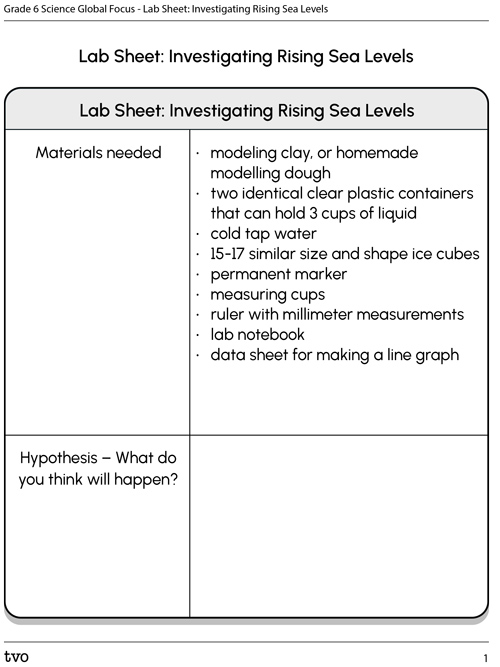
Press the Activity button to access the Lab Sheet: Investigating Rising Sea Levels.
Activity (Open PDF in a new tab)- modeling clay, or homemade modelling dough
- two identical clear plastic containers that can hold 3 cups of liquid
- cold tap water
- 15-17 similar size and shape ice cubes
- permanent marker
- measuring cups
- ruler with millimeter measurements
- lab notebook
- data sheet for making a line graph
- Press equal amounts of modelling clay into one side of each plastic container, making a smooth, flat surface representing land rising out of the ocean. It should not cover more than one-third of the bottom of the container.
- In one container, place ice cubes on top of the clay to represent land ice. Make sure that the water will be able to drain into the rest of the container and is not trapped in the clay.
- In the other container, place the same amount of ice cubes in the bottom of the container. This represents sea ice. Fill the container with cold water up to the level of clay, but not over it.
- In the land ice container, pour water into the container, so that both containers have an equal depth of water.
- Record the depth of water in each container using a ruler; also record the time. You can also mark the water level with a permanent marker on the outside of the container.
- At regular time intervals, measure the water level in both containers and record it on your data sheet. Compare the water level with the marked line in the clay. Allow the ice in both tubs to melt completely. This may take some time.
- Once the ice has melted, create a line graph for both tubs.
Check out this video to explore a demonstration of the Investigating Rising Sea Levels experiment. Please note that materials and procedure in the video may vary slightly from what is listed in the previous tabs.
Fresh water and salt water
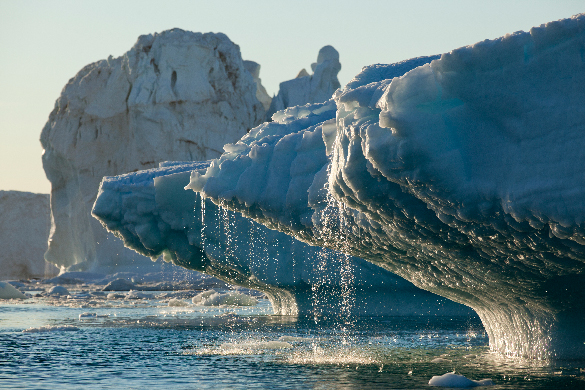
Even though over 70% of the Earth is made up of water, only about 3% of that water is freshwater. A little more than half of the freshwater that exists on our planet is stored in glaciers and ice sheets. When this freshwater melts into the ocean, it turns into salt water. As these glaciers and ice sheets continue to melt at a faster than usual rate, the Earth loses a significant source of ifs freshwater stores.
How does this affect species in their environment?
Because glaciers form on land, the freshwater they are made up of are a water source for the soils and water systems of the lands they are formed on. This freshwater source feeds the vegetation in the area, which is food for different animal species sharing the same habitat. In the short term of rapidly melting glaciers, the ground will have lots of freshwater, but as the glaciers melt and reduce significantly over time, in the long term, there will be much less freshwater available to support and sustain this habitat. This will directly impact the vegetation that grows in this area, as well as the food source many animals who depends on the vegetation. A loss of freshwater directly impacts multiple species in these habitats and threatens overall biodiversity in the area. This melting will also lead to flooding in this area which will affect the entire habitat and the organisms within it. The impact on the biodiversity in this area will be great as species will struggle to survive.
Pause and Reflect
Pause and reflect
How can the United Nations Goal #13 of Climate Action and raising awareness of the impacts of climate change make a difference in areas where biodiversity is affected?
Record your answer using a method of your choice.
Consolidation
Bringing it all together
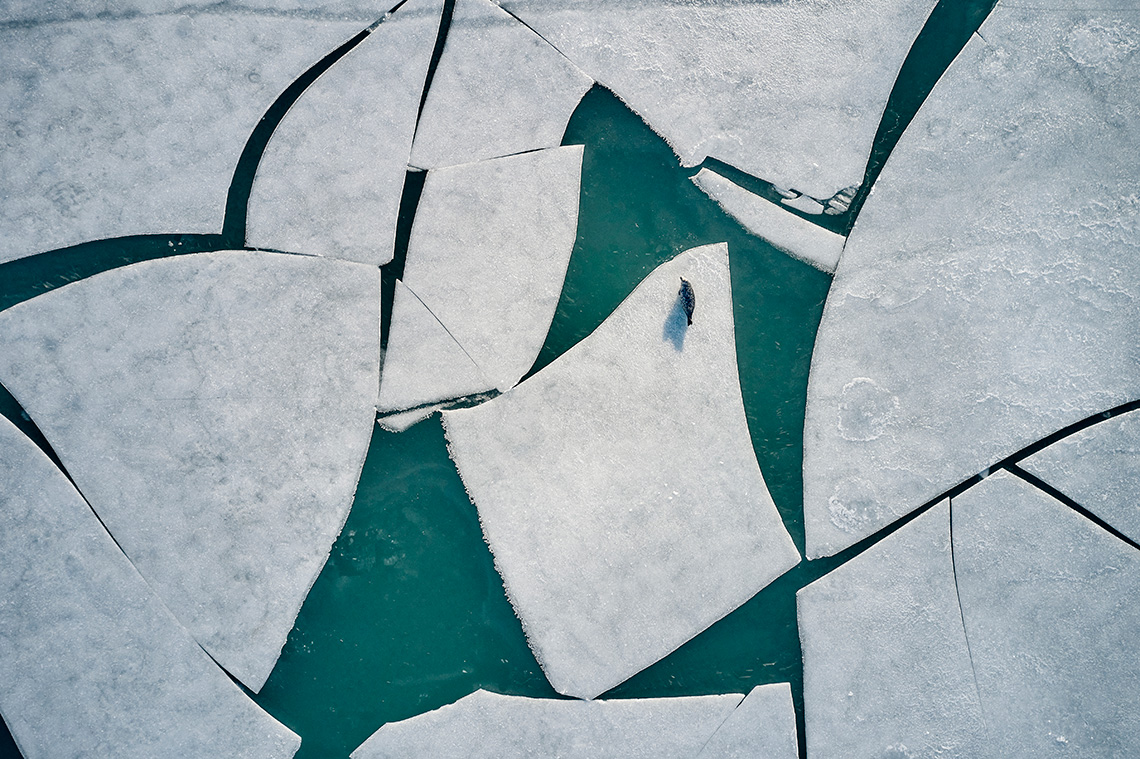
Use information shared in this learning activity to answer the following questions about climate change and biodiversity.
Select the correct answer, then press ‘Check Answer’ to see how you did.
Consolidate your learning
Select two to three of the following questions to answer using a method of your choice.
- Describe how melting glaciers contribute to global sea rising and why it is a problem.
- Describe how sea rising and sea warming affect biodiversity.
- How did the experiment help you to understand the effect of melting land ice and sea ice?
- Describe how the connection between species, and between species and their environment, is impacted by rising and warming sea levels.
- Return to your Mind Map from the Minds On section. How might you change the information in your mind map now?
Record your ideas in a notebook or using another method of your choice.
Reflection
As you read through these descriptions, which sentence best describes how you are feeling about your understanding of this learning activity? Press the button that is beside this sentence.
I feel…
Now, record your ideas using a voice recorder, speech-to-text, or writing tool.
